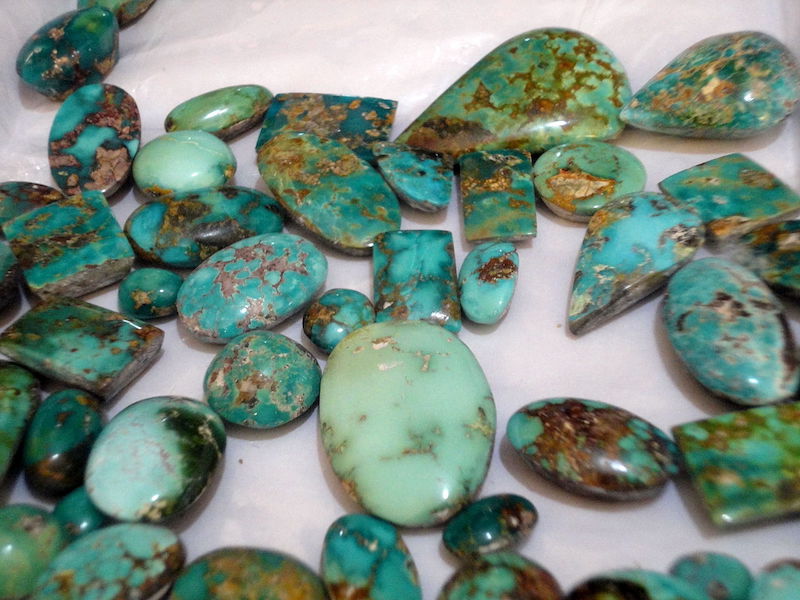
If you’re born in December, you have a choice of three birthstones: turquoise, zircon and tanzanite. Turquoise, a soft gemstone used in jewelry and ornaments, has a rich history dating to antiquity. Zircons are not well-known gemstones, but they make absolutely stunning jewelry. Tanzanite is an exquisite clear blue-violet crystal found only in Tanzania.
Why do some months have one birthstone but others have two or three? According the website onecklace.com, multiple stones for some months allow more affordable options in addition to the traditional and more expensive stones.
December birthstone: turquoise
To chemists and geologists, turquoise is copper aluminum phosphate. It forms when rainwater or melted snow percolates through copper ore deposits called copper porphyry. Water interacts with copper sulfides in the ore to form an acidic solution. This copper-carrying acidic water, when it reacts with aluminum and potassium in the rocks, precipitates turquoise into cavities. You can find turquoise in weathered volcanic rock and sedimentary rock in arid locations.
Turquoise is a relatively soft gemstone, with a Mohs scale of five to six. You can scratch or break turquoise with moderate force. Oil and pigments easily discolor this porous opaque stone. It also changes color when it loses some of its water content.
Hard, relatively non-porous, compact stones have the best appearance because the stone can be finely polished. “Softer” varieties that are more porous are treated with oil, paraffin, liquid plastic or water glass to enhance its durability and color.
Copper gives a sky-blue shade to turquoise, while iron gives it a greener tone. The most valued variety of turquoise is an intense sky-blue color, like the color of a robin’s egg. Ochre and brown-black veins, often found in the gemstones, are inclusions from the surrounding rock matrix.
Turquoise facts
Some of the best turquoise in the world comes from Iran, famous for its sky-blue stones from Neyshabur. In Egypt, people have mined turquoise in the Sinai Peninsula for over 5,000 years. Turquoise is found in many US southwestern states: Arizona, California, Colorado, New Mexico and Nevada. This stone also occurs in Afghanistan, Australia, China, India, Tibet, Mexico and Brazil.
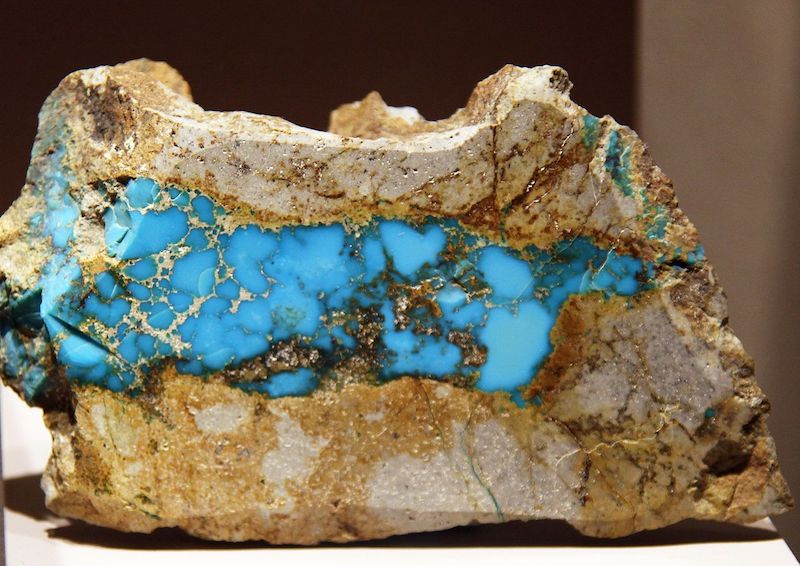
The word turquoise originated from the French phrase pierre turquoise, meaning Turkish stone. That’s because people brought the gemstone to Europe by Venetian merchants who acquired it from traders in Turkey.
In antiquity, turquoise was used as jewelry by the ruling classes of civilizations in Africa, Asia and the Americas. People have found beads dating to the late 6th millennium BCE in ancient Iraq. Turquoise bracelets were on the arm of a woman in the tomb of Zer, a pharaoh that ruled Egypt around 3000 BCE. A 3,700-year-old dragon relic from the Xia Dynasty, made from over 2,000 pieces of turquoise, was in the tomb of a nobleman in central China.
Turquoise in the Americas
Turquoise has a rich history in the American Southwest. Native Americans have been using this gemstone to create jewelry and ornamental pieces for several thousand years. The Apache, Navajo, Pueblo, and Zuni in particular, are known for their turquoise jewelry.
In the Zuni language, the word for turquoise is sky stone. During the growing season in summer, Pueblo dancers wear turquoise to encourage rainfall. The Navajo associate turquoise with health and protection, using the stone in important rites of passage. While the Apache believed that turquoise lay at the end of a rainbow, and that turquoise attached to a bow or gun ensured an accurate aim.
Turquoise was a part of Pre-Columbian cultures in Mexico, Central America, and South America. In Peru, prehistoric tribes made small objects such as beads, figurines and artifacts with turquoise inlays. For the Aztec, turquoise was popular in ornaments. It also had important religious and ceremonial uses. For example, a high priest involved in human sacrifice wore a turquoise pendant hung from his underlip. A notable Aztec art form was intricate turquoise mosaics, like that of a turquoise mosaic mask used in the interment of a king.

/ Flickr.
Turquoise lore
Some people consider turquoise a love charm. When received as a gift, it is supposed to symbolize a pledge of affection. Shakespeare used this lore in The Merchant of Venice. In it, Leah gave a turquoise ring to Shylock when he was a bachelor, hoping it would win his affections so he would ask her to marry him.
There are many other superstitions associated with turquoise. In the twelfth century, an Arabian writing declared, “the turquoise shines when the air is pure and becomes pale when it is dim.” They also believed that its color changed with the weather. In the 13th century, people believed it would protect its owner from injury if he fell off a horse.
George Frederick Kunz’s book, The Curious Lore of Precious Stones, stated that diamonds and turquoises supposedly lost their powers if sold:
The spirit dwelling in the stone was thought to take offence at the idea of being bought and sold, and was supposed to depart from the stone, leaving it nothing more than a bit of senseless matter. If, however, the diamond (or turquoise) were offered as a pledge of love or friendship, the spirit was quite willing to transfer its good offices from one owner to another.
There were also health myths associated with turquoise. People believed the stone changed color when its wearer became ill. Some said it was an effective treatment for scorpion stings and pain from evil influences. Just looking at turquoise supposedly strengthen the eyes.
December birthstone: zircon
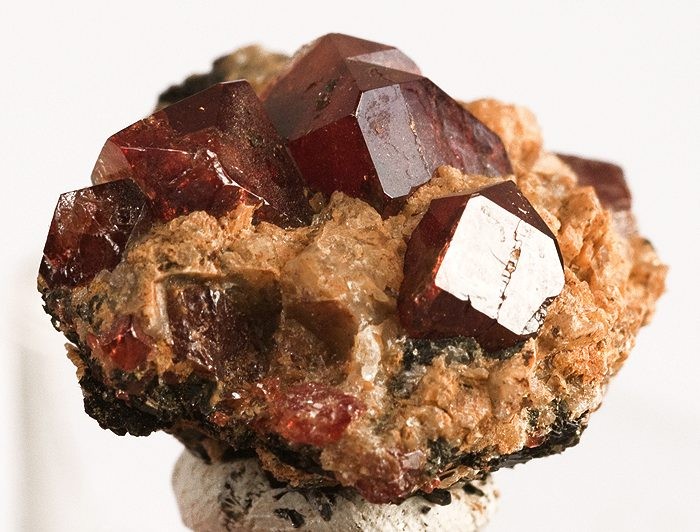
Zircon is a mineral of the elements zirconium and silicon (zirconium silicate). Small crystals, just a few millimeters in size, are commonly in most igneous rock. With a Moh’s hardness scale of 7.5, zircon is hard enough to survive the geologic forces that create metamorphic and sedimentary rock. But large zircon crystals are rare. They’re formed mainly in pegmatites (coarse-grained igneous rock) and carbonatites. But due to weathering of gem-bearing rocks, most zircons are in alluvial and beach deposits.
The name zircon may have come from the Arabic words zarquin, meaning red. Or perhaps from the Persian word zargus, meaning gold-colored.
Major sources of gemstone-quality zircon are Thailand, Cambodia, Vietnam and Sri Lanka. The gemstones also occur in Myanmar, France, Norway, Australia and Canada.
Colors of zircon
Over vast spans of geologic time, forces have worked within zirconium silicate crystals to change their molecular structure and color. Uranium and thorium inclusions emit radiation that alters the original crystal structure. A glass-like material is formed, with colors of red to brown, orange and yellow. Green is the rarest of the natural colors. Since the 1920s, most gemstones have undergone heat treatment to bring out their colors. This produces colorless zircons, as well as blue and golden stones.

The creation of blue stones is in an interesting story relayed in Gems and Crystals by Anna S. Sofianides and George E. Harlow:
In the 1920s, a new blue gemstone suddenly appeared in the market. Endowed with spectacular brilliance, it was an immediate hit.
The creation of the blue zircon
The gems, it turned out, were zircons, normally brown to green, but never before blue. George F. Kunz, the legendary Tiffany gemologist, immediately suspected trickery; not only were there extraordinary stones available in abundance, but they were available all over the world! Upon Kunz’s behest, a colleague made inquiries during a trip to Siam (Thailand) and learned that a large deposit of unattractive brown zircon had stimulated color-improvement experimentation by local entrepreneurs. Heating in an oxygen-free environment made the drab material into “new” blue stones, which vendors sent to outlets worldwide. Even after finding out about the deception, the market simply accepted the information and the demand for the new gems continued unabated.
Among zircon customers, blue stones are a clear favorite. Red and green colors are also valuable. Colorless zircons are excellent imitators of diamonds, in appearance only, with a brilliant fire almost as dazzling as the real thing. However, zircon can be brittle and cutting takes great care. It breaks with a well-placed knock, due to internal stresses in the crystal caused by radiation damage and heat treatment. But it remains in demand for its stunning beauty. Other factors that affect pricing of the gemstones are clarity and an absence of visible inclusions.
Zircon lore
Green zircon was among the stones of the Kalpa Tree of the Hindu religion, where it represented the tree’s foliage. This tree was a symbolic offering to the gods. Hindu poets of the 19th century described it as part of a glowing ensemble of precious stones that also included sapphires, diamonds and topaz.
The hyacinth and jacinth, reddish-brown and orange-red varieties of zircon, were a favorite stone of ancient Arabs, even mentioned in the famed “Arabian Nights.”
During the 14th century, zircon was popular as a safeguard against the Black Death, the great plague that wiped out a quarter of the population of Europe. People believed the stone possessed healing powers: to induce sleep, as an antidote against poison, and as an aid to digestion.
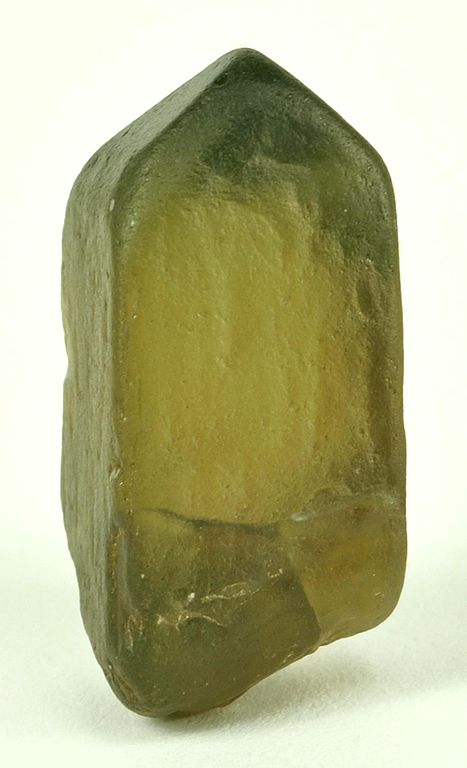
December birthstone: tanzanite
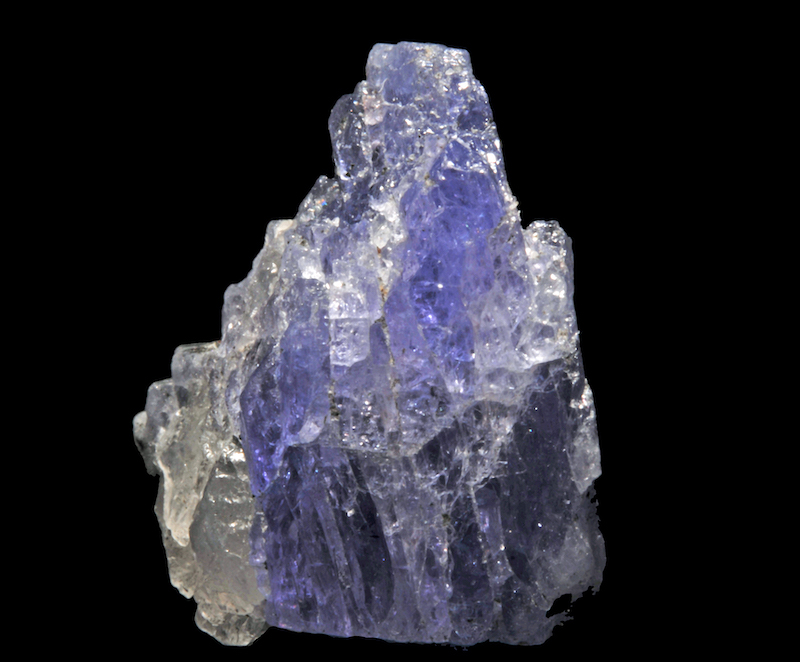
Tanzanite is an unusual form of the mineral zoisite (calcium aluminium hydroxyl sorosilicate). Its colors, blue and violet, are due to the presence of vanadium in the zoisite crystals. This gemstone formed 585 million years ago under extreme heat during intense plate tectonic activity, in a place that would someday become Mount Kilimanjaro in northern Tanzania.
Today, you can only find tanzanite in the Merelani Hills near the foot of Mount Kilimanjaro.
Colors from different angles
In its natural form, tanzanite appears brown, yellowish green, blue and violet, flashing these colors when viewed from different angles. This phenomenon is pleochroism, where you can see different colors depending on how light hits the gemstone.
The type of lighting can also make a difference. Under fluorescent lights, tanzanite appears bluer, while under incandescent light, more violet hues emerge.
Most crystals used in jewelry received doses of heat to remove the brownish color found in the natural tanzanite. The results are more intensely blue and violet gems. On rare occasions, heated stones can produce a green gem with secondary blue and violet colors. For cut gems, cutters can influence their overall color by how they craft the gem.
Tanzanite’s recent history
While most birthstones have histories spanning hundreds and even several thousands of years, tanzanite’s story began in 1967. A Masai tribesman found unusual clear violet-blue crystals in the Merelani Hills in northern Tanzania. He notified a local tailor and prospector, Manuel d’Souza who, upon finding the gemstones, filed the first of many mining claims.
Initially, d’Souza thought they were sapphires. But no one knew for sure. The stones made their way to geologists at the Gemological Institute of America where they identified them as an unusual form of zoisite.
The famed jewelry purveyors, Tiffany & Company, took an interest in the gem. In 1968, they began a marketing campaign. To make the gems more appealing to buyers, they renamed blue zoisite to tanzanite, in honor of its country of origin. In 2002, the American Gem Trade Association selected tanzanite to join turquoise and zircon as December birthstones.

Bottom line: Turquoise, zircon and tanzanite, three very uniquely different gemstones, are the birthstones for December.
Beyond the December birthstone: birthstones for all months
January birthstone
February birthstone
March birthstone
April birthstone
May birthstone
June birthstone
July birthstone
August birthstone
September birthstone
October birthstone
November birthstone
December birthstone
The post December birthstone: turquoise, zircon or tanzanite first appeared on EarthSky.
from EarthSky https://ift.tt/3DsJi3f

If you’re born in December, you have a choice of three birthstones: turquoise, zircon and tanzanite. Turquoise, a soft gemstone used in jewelry and ornaments, has a rich history dating to antiquity. Zircons are not well-known gemstones, but they make absolutely stunning jewelry. Tanzanite is an exquisite clear blue-violet crystal found only in Tanzania.
Why do some months have one birthstone but others have two or three? According the website onecklace.com, multiple stones for some months allow more affordable options in addition to the traditional and more expensive stones.
December birthstone: turquoise
To chemists and geologists, turquoise is copper aluminum phosphate. It forms when rainwater or melted snow percolates through copper ore deposits called copper porphyry. Water interacts with copper sulfides in the ore to form an acidic solution. This copper-carrying acidic water, when it reacts with aluminum and potassium in the rocks, precipitates turquoise into cavities. You can find turquoise in weathered volcanic rock and sedimentary rock in arid locations.
Turquoise is a relatively soft gemstone, with a Mohs scale of five to six. You can scratch or break turquoise with moderate force. Oil and pigments easily discolor this porous opaque stone. It also changes color when it loses some of its water content.
Hard, relatively non-porous, compact stones have the best appearance because the stone can be finely polished. “Softer” varieties that are more porous are treated with oil, paraffin, liquid plastic or water glass to enhance its durability and color.
Copper gives a sky-blue shade to turquoise, while iron gives it a greener tone. The most valued variety of turquoise is an intense sky-blue color, like the color of a robin’s egg. Ochre and brown-black veins, often found in the gemstones, are inclusions from the surrounding rock matrix.
Turquoise facts
Some of the best turquoise in the world comes from Iran, famous for its sky-blue stones from Neyshabur. In Egypt, people have mined turquoise in the Sinai Peninsula for over 5,000 years. Turquoise is found in many US southwestern states: Arizona, California, Colorado, New Mexico and Nevada. This stone also occurs in Afghanistan, Australia, China, India, Tibet, Mexico and Brazil.

The word turquoise originated from the French phrase pierre turquoise, meaning Turkish stone. That’s because people brought the gemstone to Europe by Venetian merchants who acquired it from traders in Turkey.
In antiquity, turquoise was used as jewelry by the ruling classes of civilizations in Africa, Asia and the Americas. People have found beads dating to the late 6th millennium BCE in ancient Iraq. Turquoise bracelets were on the arm of a woman in the tomb of Zer, a pharaoh that ruled Egypt around 3000 BCE. A 3,700-year-old dragon relic from the Xia Dynasty, made from over 2,000 pieces of turquoise, was in the tomb of a nobleman in central China.
Turquoise in the Americas
Turquoise has a rich history in the American Southwest. Native Americans have been using this gemstone to create jewelry and ornamental pieces for several thousand years. The Apache, Navajo, Pueblo, and Zuni in particular, are known for their turquoise jewelry.
In the Zuni language, the word for turquoise is sky stone. During the growing season in summer, Pueblo dancers wear turquoise to encourage rainfall. The Navajo associate turquoise with health and protection, using the stone in important rites of passage. While the Apache believed that turquoise lay at the end of a rainbow, and that turquoise attached to a bow or gun ensured an accurate aim.
Turquoise was a part of Pre-Columbian cultures in Mexico, Central America, and South America. In Peru, prehistoric tribes made small objects such as beads, figurines and artifacts with turquoise inlays. For the Aztec, turquoise was popular in ornaments. It also had important religious and ceremonial uses. For example, a high priest involved in human sacrifice wore a turquoise pendant hung from his underlip. A notable Aztec art form was intricate turquoise mosaics, like that of a turquoise mosaic mask used in the interment of a king.

/ Flickr.
Turquoise lore
Some people consider turquoise a love charm. When received as a gift, it is supposed to symbolize a pledge of affection. Shakespeare used this lore in The Merchant of Venice. In it, Leah gave a turquoise ring to Shylock when he was a bachelor, hoping it would win his affections so he would ask her to marry him.
There are many other superstitions associated with turquoise. In the twelfth century, an Arabian writing declared, “the turquoise shines when the air is pure and becomes pale when it is dim.” They also believed that its color changed with the weather. In the 13th century, people believed it would protect its owner from injury if he fell off a horse.
George Frederick Kunz’s book, The Curious Lore of Precious Stones, stated that diamonds and turquoises supposedly lost their powers if sold:
The spirit dwelling in the stone was thought to take offence at the idea of being bought and sold, and was supposed to depart from the stone, leaving it nothing more than a bit of senseless matter. If, however, the diamond (or turquoise) were offered as a pledge of love or friendship, the spirit was quite willing to transfer its good offices from one owner to another.
There were also health myths associated with turquoise. People believed the stone changed color when its wearer became ill. Some said it was an effective treatment for scorpion stings and pain from evil influences. Just looking at turquoise supposedly strengthen the eyes.
December birthstone: zircon

Zircon is a mineral of the elements zirconium and silicon (zirconium silicate). Small crystals, just a few millimeters in size, are commonly in most igneous rock. With a Moh’s hardness scale of 7.5, zircon is hard enough to survive the geologic forces that create metamorphic and sedimentary rock. But large zircon crystals are rare. They’re formed mainly in pegmatites (coarse-grained igneous rock) and carbonatites. But due to weathering of gem-bearing rocks, most zircons are in alluvial and beach deposits.
The name zircon may have come from the Arabic words zarquin, meaning red. Or perhaps from the Persian word zargus, meaning gold-colored.
Major sources of gemstone-quality zircon are Thailand, Cambodia, Vietnam and Sri Lanka. The gemstones also occur in Myanmar, France, Norway, Australia and Canada.
Colors of zircon
Over vast spans of geologic time, forces have worked within zirconium silicate crystals to change their molecular structure and color. Uranium and thorium inclusions emit radiation that alters the original crystal structure. A glass-like material is formed, with colors of red to brown, orange and yellow. Green is the rarest of the natural colors. Since the 1920s, most gemstones have undergone heat treatment to bring out their colors. This produces colorless zircons, as well as blue and golden stones.

The creation of blue stones is in an interesting story relayed in Gems and Crystals by Anna S. Sofianides and George E. Harlow:
In the 1920s, a new blue gemstone suddenly appeared in the market. Endowed with spectacular brilliance, it was an immediate hit.
The creation of the blue zircon
The gems, it turned out, were zircons, normally brown to green, but never before blue. George F. Kunz, the legendary Tiffany gemologist, immediately suspected trickery; not only were there extraordinary stones available in abundance, but they were available all over the world! Upon Kunz’s behest, a colleague made inquiries during a trip to Siam (Thailand) and learned that a large deposit of unattractive brown zircon had stimulated color-improvement experimentation by local entrepreneurs. Heating in an oxygen-free environment made the drab material into “new” blue stones, which vendors sent to outlets worldwide. Even after finding out about the deception, the market simply accepted the information and the demand for the new gems continued unabated.
Among zircon customers, blue stones are a clear favorite. Red and green colors are also valuable. Colorless zircons are excellent imitators of diamonds, in appearance only, with a brilliant fire almost as dazzling as the real thing. However, zircon can be brittle and cutting takes great care. It breaks with a well-placed knock, due to internal stresses in the crystal caused by radiation damage and heat treatment. But it remains in demand for its stunning beauty. Other factors that affect pricing of the gemstones are clarity and an absence of visible inclusions.
Zircon lore
Green zircon was among the stones of the Kalpa Tree of the Hindu religion, where it represented the tree’s foliage. This tree was a symbolic offering to the gods. Hindu poets of the 19th century described it as part of a glowing ensemble of precious stones that also included sapphires, diamonds and topaz.
The hyacinth and jacinth, reddish-brown and orange-red varieties of zircon, were a favorite stone of ancient Arabs, even mentioned in the famed “Arabian Nights.”
During the 14th century, zircon was popular as a safeguard against the Black Death, the great plague that wiped out a quarter of the population of Europe. People believed the stone possessed healing powers: to induce sleep, as an antidote against poison, and as an aid to digestion.

December birthstone: tanzanite

Tanzanite is an unusual form of the mineral zoisite (calcium aluminium hydroxyl sorosilicate). Its colors, blue and violet, are due to the presence of vanadium in the zoisite crystals. This gemstone formed 585 million years ago under extreme heat during intense plate tectonic activity, in a place that would someday become Mount Kilimanjaro in northern Tanzania.
Today, you can only find tanzanite in the Merelani Hills near the foot of Mount Kilimanjaro.
Colors from different angles
In its natural form, tanzanite appears brown, yellowish green, blue and violet, flashing these colors when viewed from different angles. This phenomenon is pleochroism, where you can see different colors depending on how light hits the gemstone.
The type of lighting can also make a difference. Under fluorescent lights, tanzanite appears bluer, while under incandescent light, more violet hues emerge.
Most crystals used in jewelry received doses of heat to remove the brownish color found in the natural tanzanite. The results are more intensely blue and violet gems. On rare occasions, heated stones can produce a green gem with secondary blue and violet colors. For cut gems, cutters can influence their overall color by how they craft the gem.
Tanzanite’s recent history
While most birthstones have histories spanning hundreds and even several thousands of years, tanzanite’s story began in 1967. A Masai tribesman found unusual clear violet-blue crystals in the Merelani Hills in northern Tanzania. He notified a local tailor and prospector, Manuel d’Souza who, upon finding the gemstones, filed the first of many mining claims.
Initially, d’Souza thought they were sapphires. But no one knew for sure. The stones made their way to geologists at the Gemological Institute of America where they identified them as an unusual form of zoisite.
The famed jewelry purveyors, Tiffany & Company, took an interest in the gem. In 1968, they began a marketing campaign. To make the gems more appealing to buyers, they renamed blue zoisite to tanzanite, in honor of its country of origin. In 2002, the American Gem Trade Association selected tanzanite to join turquoise and zircon as December birthstones.

Bottom line: Turquoise, zircon and tanzanite, three very uniquely different gemstones, are the birthstones for December.
Beyond the December birthstone: birthstones for all months
January birthstone
February birthstone
March birthstone
April birthstone
May birthstone
June birthstone
July birthstone
August birthstone
September birthstone
October birthstone
November birthstone
December birthstone
The post December birthstone: turquoise, zircon or tanzanite first appeared on EarthSky.
from EarthSky https://ift.tt/3DsJi3f

Aucun commentaire:
Enregistrer un commentaire